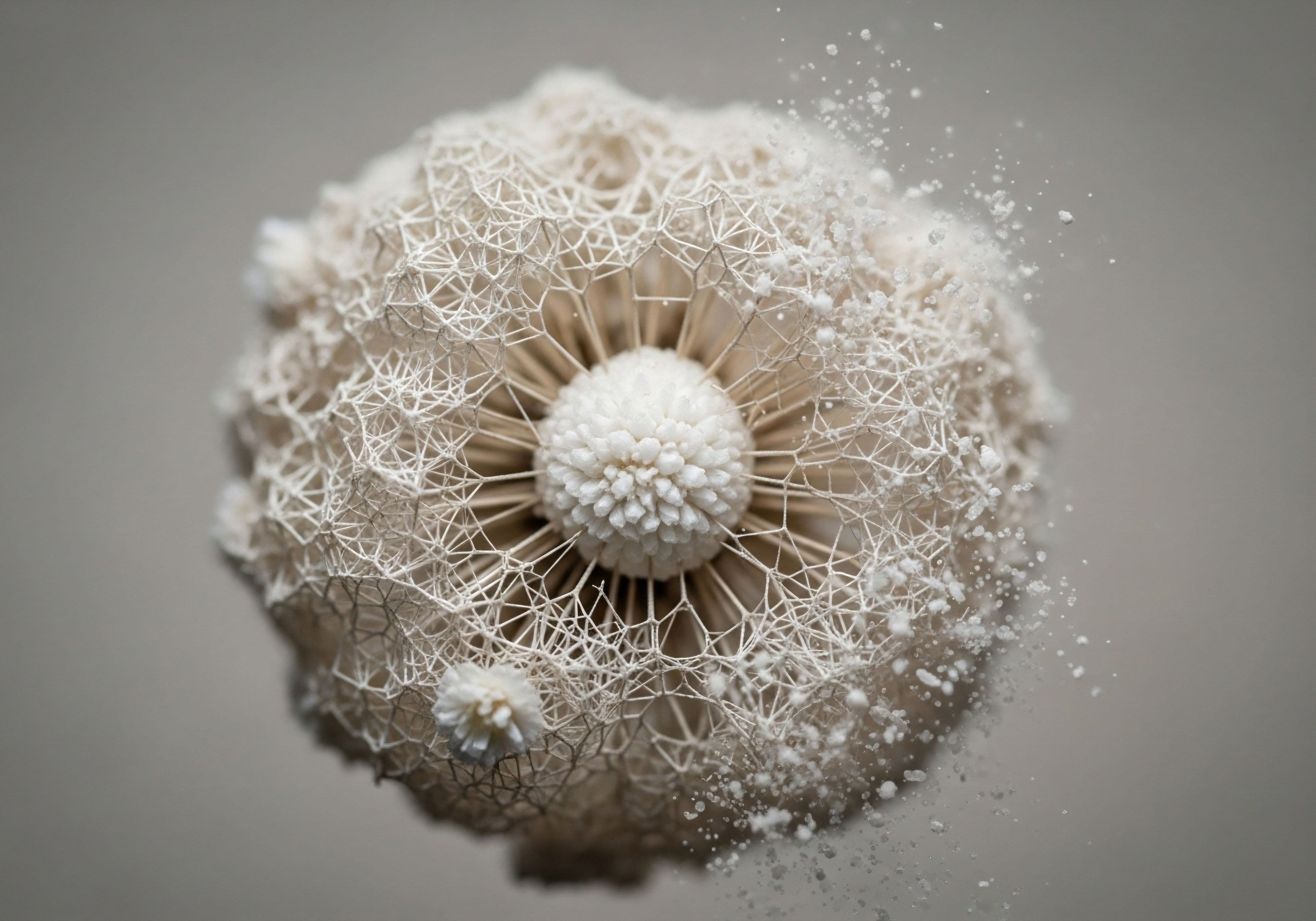

Fundamentals
You may feel a persistent sense of fatigue, a subtle decline in your vitality that you cannot quite name. This experience, a feeling of your body working against itself, is a valid and common starting point for a deeper health inquiry. The sensation often has a biological correlate, rooted in the complex processes occurring within your cells.
At the center of this dynamic is the relationship between your body’s healing mechanisms and a state of persistent internal stress known as chronic inflammation.

The Body’s Two-Sided Response to Injury
Inflammation is a fundamental, life-sustaining process. When you sustain an injury, your immune system dispatches a team of first responders. These cells create what is known as acute inflammation, a coordinated effort to clear away damaged tissue and pathogens. This response is powerful, swift, and, most importantly, temporary.
Once the threat is neutralized, the inflammatory signals subside, and the process of rebuilding, or cellular regeneration, begins. This is your body’s innate system for repair, a remarkable biological program designed to restore function and maintain tissue integrity.
A different scenario unfolds when the initial trigger for inflammation is not resolved. This could be due to a persistent infection, prolonged exposure to irritants, or internal metabolic dysfunction. The emergency response never fully switches off. This creates a state of chronic inflammation, a low-grade, smoldering fire within your tissues.
This persistent inflammatory state fundamentally alters the cellular environment, shifting the body’s priority from repair and rebuilding to a constant state of defense. This internal conflict is where the journey to understanding diminished vitality truly begins.

The Endocrine System the Master Conductor
Overseeing your body’s long-term strategy, including growth, repair, and metabolism, is the endocrine system. This intricate network of glands produces hormones, which function as chemical messengers, traveling through your bloodstream to instruct cells and organs on their specific roles.
Think of this system as the master conductor of your body’s orchestra, ensuring every section plays in time and harmony. Hormones like testosterone, estrogen, and growth hormone are critical players in this symphony, directly influencing how your cells respond to stress and how efficiently they regenerate.
When chronic inflammation is present, it introduces disruptive noise into this finely tuned system. The inflammatory signals can interfere with hormonal production and the ability of cells to receive hormonal messages. The result is a dysregulation of the very systems designed to keep you healthy and resilient.
Your body’s capacity for cellular regeneration becomes compromised, not from a single, identifiable cause, but from a systemic breakdown in communication. Understanding this connection between inflammation, your endocrine system, and cellular repair is the first step toward reclaiming your biological vitality.
Chronic inflammation disrupts the internal environment, compelling the body to prioritize a constant state of defense over its natural processes of cellular repair and regeneration.

Cellular Senescence a State of Arrested Repair
One of the direct consequences of a chronically inflamed internal environment is a phenomenon called cellular senescence. When a cell endures significant stress or damage, such as the persistent signaling from chronic inflammation, it can enter a state of irreversible growth arrest. A senescent cell is not dead; it remains metabolically active. However, it ceases to divide and contribute to tissue repair.
These senescent cells begin to secrete their own cocktail of pro-inflammatory signals, known as the Senescence-Associated Secretory Phenotype (SASP). This creates a self-perpetuating cycle ∞ inflammation causes cells to become senescent, and senescent cells, in turn, release substances that promote more inflammation.
This vicious loop actively suppresses the regenerative capacity of surrounding healthy cells, particularly stem cells, which are essential for rebuilding tissues. The accumulation of senescent cells is a key biological mechanism through which chronic inflammation directly sabotages your body’s ability to heal and regenerate, contributing to the slow decline in function and vitality that you may be experiencing.


Intermediate
To fully grasp how chronic inflammation undermines cellular regeneration, we must examine the specific biological conversations taking place between your immune and endocrine systems. The hormones you produce are not passive bystanders; they are potent modulators of the inflammatory process. Their balance and availability directly dictate whether your body’s response to stress promotes healing or perpetuates damage. A disruption in this hormonal equilibrium can create a permissive environment for inflammation to become chronic, fundamentally altering tissue repair mechanisms.

Hormonal Influence on the Inflammatory Response
Your sex hormones, primarily testosterone and estrogen, exert powerful influence over your immune cells. They can be thought of as system-wide regulators, capable of either dampening or amplifying inflammatory signals. This regulatory capacity is a cornerstone of maintaining homeostasis, the stable internal environment necessary for health.
Androgens, such as testosterone, generally have an immune-suppressive effect. They can help temper the intensity of the inflammatory response, ensuring it remains controlled and resolves appropriately. Studies have shown that healthy testosterone levels are associated with lower levels of key inflammatory markers like Tumor Necrosis Factor-alpha (TNF-α) and Interleukin-6 (IL-6).
When testosterone levels are suboptimal, as seen in conditions like hypogonadism, this natural anti-inflammatory brake is weakened. The inflammatory response can become exaggerated and prolonged, hindering the transition to the healing phase.
Estrogens have a more complex, context-dependent role. They can promote certain immune responses, which is beneficial for fighting off pathogens, but they also play a crucial part in accelerating wound repair by modulating inflammation. The balance between androgens and estrogens is what truly governs the overall inflammatory tone of the body. A shift in this ratio can disrupt the delicate coordination required for efficient cellular regeneration.
The balance of sex hormones like testosterone and estrogen directly regulates the body’s inflammatory tone, influencing the transition from tissue injury to successful repair.

Key Hormones and Their Role in Tissue Regeneration
The following table outlines the distinct roles of key hormones in the processes of inflammation and cellular repair, highlighting their importance in maintaining regenerative capacity.
| Hormone | Role in Inflammation | Impact on Cellular Regeneration |
|---|---|---|
| Testosterone | Generally exerts anti-inflammatory effects, reducing pro-inflammatory cytokines like TNF-α and IL-6. | Supports muscle and bone tissue repair. Low levels are linked to slower wound healing and increased inflammation. |
| Estrogen | Has a complex modulatory role, sometimes promoting and sometimes reducing inflammation depending on the context. | Accelerates cutaneous wound healing and promotes revascularization of damaged tissue. |
| Growth Hormone (GH) | Modulates immune cell function and can have both pro- and anti-inflammatory effects. | Stimulates the production of Insulin-like Growth Factor 1 (IGF-1), which is critical for cell growth, proliferation, and repair in virtually all tissues. |
| Cortisol | A potent anti-inflammatory hormone in the short term, resolving acute inflammation. | Chronic elevation due to stress disrupts healing, suppresses immune function, and impairs collagen production, hindering tissue repair. |

Peptide Protocols for Cellular Optimization
For individuals seeking to restore their body’s regenerative potential, certain clinical protocols are designed to optimize the endocrine system’s function. Peptide therapy uses specific chains of amino acids to signal the body to produce its own hormones, offering a more physiological approach to restoring balance. These therapies can directly address the downstream consequences of chronic inflammation.
- Sermorelin ∞ This peptide is an analog of Growth Hormone-Releasing Hormone (GHRH). It stimulates the pituitary gland to naturally produce and release Growth Hormone (GH). This action supports cellular regeneration, improves sleep quality (a critical component of repair), and has been shown to have anti-inflammatory effects.
- Ipamorelin / CJC-1295 ∞ This combination represents a powerful approach to increasing GH levels. Ipamorelin is a GH secretagogue that mimics the hormone ghrelin, while CJC-1295 is another GHRH analog. Together, they create a strong, synergistic pulse of GH release. This supports the growth of lean muscle mass, promotes fat loss, and enhances tissue repair and collagen production, directly counteracting the degenerative effects of chronic inflammation.
- PT-141 ∞ This peptide functions differently, primarily targeting pathways related to sexual health and function, which can also be impacted by systemic inflammation and hormonal imbalance.
These protocols are designed to recalibrate the body’s internal signaling, creating an environment that favors regeneration over degeneration. By optimizing the function of the endocrine system, it becomes possible to mitigate the suppressive effects of chronic inflammation on cellular repair.


Academic
A sophisticated analysis of how chronic inflammation impairs cellular regeneration requires a systems-biology perspective, moving beyond isolated pathways to appreciate the intricate crosstalk between the immune system, the endocrine system, and cellular machinery. The central nexus of this interaction is the Hypothalamic-Pituitary-Gonadal (HPG) axis, the primary regulatory loop governing sex hormone production. Chronic inflammatory states induce profound dysregulation within this axis, creating a self-amplifying cycle of hormonal suppression and impaired tissue homeostasis.

Inflammatory Cytokines and HPG Axis Disruption
Chronic inflammation is characterized by the sustained elevation of pro-inflammatory cytokines, such as Tumor Necrosis Factor-alpha (TNF-α), Interleukin-1β (IL-1β), and Interleukin-6 (IL-6). These signaling molecules are not merely markers of inflammation; they are bioactive agents that directly interfere with endocrine function at multiple levels.
At the hypothalamic level, these cytokines can suppress the pulsatile release of Gonadotropin-Releasing Hormone (GnRH), the master signal that initiates the entire HPG cascade. At the pituitary level, they can blunt the sensitivity of gonadotroph cells to GnRH, reducing the secretion of Luteinizing Hormone (LH) and Follicle-Stimulating Hormone (FSH).
Finally, at the gonadal level, cytokines can directly inhibit steroidogenesis in the testes and ovaries, impairing the production of testosterone and estrogen. This multi-pronged assault results in a state of functional hypogonadism, depriving the body of the very hormones needed to effectively modulate inflammation and promote repair.

Molecular Mechanisms of Impaired Regeneration
The consequences of this cytokine-induced hormonal suppression cascade down to the cellular level, sabotaging regeneration through several key mechanisms. The interplay between inflammatory signaling and hormonal deficits creates a hostile microenvironment for tissue repair.
- Inhibition of Stem Cell Function ∞ Adult stem cells are critical for tissue regeneration. Chronic inflammation impairs their function. Pro-inflammatory cytokines can push stem cells towards premature senescence or dysfunctional differentiation, compromising their ability to self-renew and generate healthy new cells. Hormones like testosterone and IGF-1 are vital for promoting stem cell proliferation and differentiation into functional tissue; their absence exacerbates this deficit.
- Promotion of Fibrosis ∞ In a healthy healing process, there is a controlled deposition of extracellular matrix to rebuild tissue structure. Chronic inflammation disrupts this process. Instead of organized repair, the sustained inflammatory signaling, particularly through molecules like Transforming Growth Factor-beta (TGF-β), can lead to excessive and disorganized collagen deposition. This results in fibrosis, or scarring, where functional tissue is replaced by non-functional connective tissue, leading to a loss of organ function.
- Induction of Cellular Senescence ∞ As previously discussed, chronic inflammation is a potent inducer of cellular senescence. From a molecular standpoint, the DNA damage and oxidative stress generated by inflammatory processes trigger cell cycle arrest pathways, such as the p16/p21 pathways. The resulting accumulation of senescent cells and their SASP further fuels the inflammatory fire and creates a powerful barrier to regeneration, a phenomenon termed “inflammaging”.

Cytokine Impact on Regenerative Pathways
The following table details the specific effects of key pro-inflammatory cytokines on cellular processes essential for regeneration, illustrating the direct molecular conflict between inflammation and healing.
| Cytokine | Molecular Action | Consequence for Cellular Regeneration |
|---|---|---|
| TNF-α | Induces oxidative stress and apoptosis in healthy cells. Suppresses anabolic signaling pathways. | Inhibits muscle protein synthesis, promotes cell death, and impairs the function of progenitor cells needed for repair. |
| IL-6 | Can have both pro- and anti-inflammatory effects, but chronic elevation promotes a pro-inflammatory state. | Chronic high levels are associated with reduced tissue repair, increased fibrosis, and the promotion of cellular senescence. |
| IL-1β | A potent inflammatory mediator that activates other cytokines and promotes matrix degradation. | Contributes to the breakdown of healthy tissue matrix, inhibits collagen synthesis, and perpetuates the inflammatory cycle. |
| TGF-β | Plays a dual role, but in chronic inflammatory states, it is a primary driver of fibrosis. | Promotes the excessive production of extracellular matrix proteins, leading to scarring and loss of tissue function. |
Pro-inflammatory cytokines directly disrupt the Hypothalamic-Pituitary-Gonadal axis, suppressing the production of vital hormones and creating a molecular environment that favors tissue degradation and fibrosis over regeneration.

Therapeutic Recalibration of the System
From an academic standpoint, therapeutic interventions like Testosterone Replacement Therapy (TRT) and Growth Hormone Peptide Therapy are not merely about supplementation. They represent a strategic intervention designed to break the vicious cycle of inflammation and endocrine suppression. By restoring crucial hormonal signals, these protocols can recalibrate the system.
Optimized testosterone levels can directly suppress the expression of TNF-α, IL-1β, and IL-6, re-establishing an anti-inflammatory environment. The subsequent increase in GH and IGF-1 from peptide therapy provides the powerful anabolic and pro-regenerative signals needed to activate quiescent stem cells, promote protein synthesis, and shift the cellular milieu from one of catabolism and fibrosis to one of anabolism and functional repair. This integrated approach addresses the root biochemical imbalances that perpetuate chronic inflammation’s destructive effects on cellular regeneration.

References
- Cutolo, M. & Seriolo, B. & Villaggio, B. & Pizzorni, C. & Craviotto, C. & Sulli, A. (2002). Androgens and estrogens modulate the immune and inflammatory responses in rheumatoid arthritis. Annals of the New York Academy of Sciences, 966, 131-42.
- Franceschi, C. & Garagnani, P. & Parini, P. & Giuliani, C. & Santoro, A. (2018). Inflammaging ∞ a new immune-metabolic viewpoint for age-related diseases. Nature Reviews Endocrinology, 14(10), 576-590.
- Mohamad, N. V. & Soelaiman, I. N. & Chin, K. Y. (2016). A concise review of testosterone and bone health. Clinical interventions in aging, 11, 1317 ∞ 1324.
- Traustadóttir, T. & Harman, S. M. & Heward, C. & Dobs, A. S. & Blackman, M. R. (2003). The effects of testosterone and growth hormone on inflammatory markers in healthy older men. The Journal of Clinical Endocrinology & Metabolism, 88(12), 5664-5669.
- Veldhuis, J. D. & Roemmich, J. N. & Richmond, E. J. & Bowers, C. Y. (2001). Endocrine control of body composition in infancy, childhood, and puberty. Endocrine, 15(1), 23-38.
- DiPietro, L. A. (1995). The role of growth factors in wound healing. Current Opinion in Otolaryngology & Head and Neck Surgery, 3(4), 266-270.
- Basisty, N. & Kale, A. & Jeon, O. H. & Kuehnemann, C. & Payne, T. & Rao, C. &. & Campisi, J. (2020). A proteomic atlas of senescence-associated secretomes for aging biomarker development. PLoS biology, 18(1), e3000599.
- Demaria, M. & Ohtani, N. & Youssef, S. A. & Rodier, F. & Toussaint, W. & Mitchell, J. R. &. & Campisi, J. (2014). An essential role for senescent cells in optimal tissue repair through secretion of PDGF-AA. Developmental cell, 31(6), 722-733.
- Ritschka, B. & Storer, M. & Mas, A. & Heinzmann, F. & Ortells, M. C. & Morton, J. P. &. & Keyes, W. M. (2017). The senescence-associated secretory phenotype induces cellular plasticity and tissue regeneration. Genes & development, 31(2), 172-183.
- Furman, D. & Campisi, J. & Verdin, E. & Carrera-Bastos, P. & Targ, S. & Franceschi, C. &. & Slavich, G. M. (2019). Chronic inflammation in the etiology of disease across the life span. Nature medicine, 25(12), 1822-1832.

Reflection
The information presented here provides a biological framework for understanding the symptoms you may be experiencing. It connects the feeling of diminished vitality to concrete processes within your body ∞ the persistent signaling of inflammation, the disruption of hormonal communication, and the resulting impairment of your innate capacity for repair.
This knowledge is a powerful tool. It reframes your health from a series of disconnected symptoms into an integrated system. Your personal health narrative is written in the language of your cells. The next step in your journey involves considering how this scientific understanding applies to your unique biology. A personalized approach, guided by clinical expertise, can help translate this knowledge into a targeted strategy for restoring your body’s inherent potential for wellness and function.



